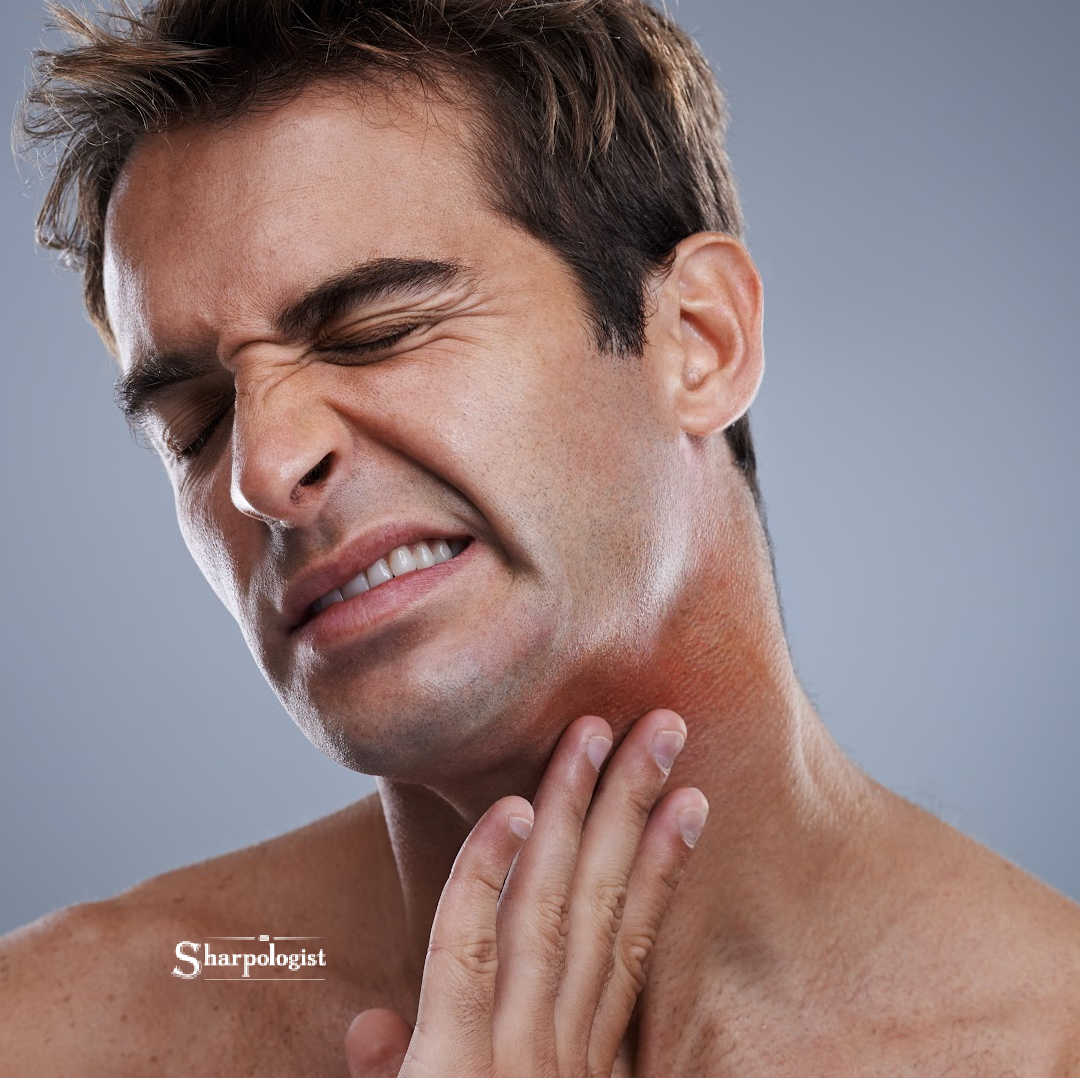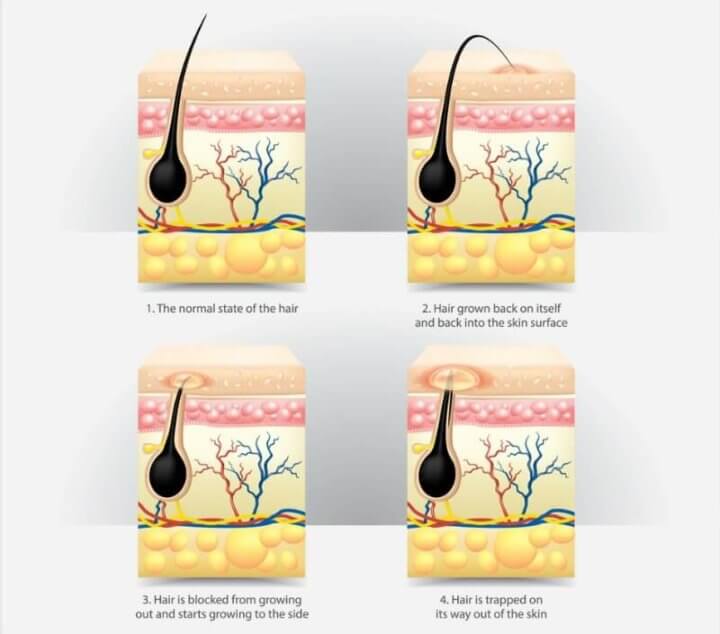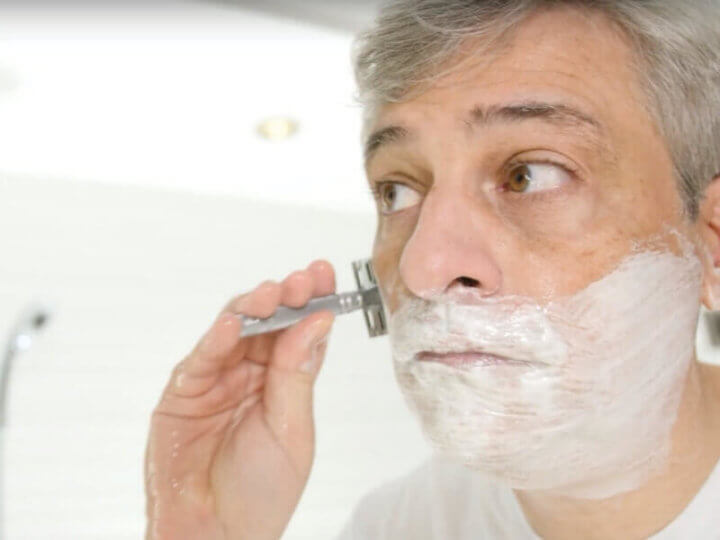
Solutions for managing stubborn ingrown hairs often lie in traditional wet shaving techniques, which you can master to improve your skin’s condition. By using proper tools like a sharp safety razor, quality shaving cream, and following a thorough pre- and post-shave routine, you can reduce irritation and prevent ingrown hairs effectively.
Key Takeaways: Proper Shaving Techniques to Minimize Ingrown Hairs
- Begin by hydrating your beard with warm water to soften hair.
- Apply a thick, protective lather and use short, gentle strokes that follow the direction of hair growth to prevent hairs from curling beneath the skin.
- Avoid stretching your skin, and maintain a blade angle of about 30 degrees for optimal cutting efficiency without excessive pressure.
- Regular cleaning of your blade between strokes not only provides a cleaner cut, it curbs bacteria buildup, which can otherwise aggravate skin and exacerbate ingrowns.
Extending beyond technique, incorporating a multi-pass system can significantly lessen ingrown hairs: first shaving with the grain, then across, and only if necessary, against the grain using light pressure. This staggered approach reduces trauma and allows follicle openings to adjust gradually, decreasing the likelihood of hairs becoming trapped under the skin. Additionally, exfoliate gently before shaving with a soft scrub or brush to remove dead skin that might block hair growth paths.
Ongoing Maintenance: Keeping Ingrown Hairs at Bay
Establishing a routine combining gentle exfoliation occasionally with consistent moisturizing leverages your skin’s natural turnover to prevent dead skin buildup that traps hairs. Using a soft-bristle brush or chemical exfoliants like salicylic acid dissolves blockages before they cause irritation. Regularly switching to a fresh, sharp blade helps minimize follicle trauma, while incorporating a weekly warm compress encourages ingrown hairs to emerge naturally and heal properly.
The key to long-term control lies in attentiveness to your skin’s changing needs. Monitoring for early signs of ingrown hairs, such as slight redness or bumps, allows for prompt intervention with targeted creams or treatments containing glycolic acid or tea tree oil. Combining these steps with your traditional wet shaving routine creates a holistic approach that not only treats but actively prevents stubborn ingrown hairs, ensuring smoother skin and a more comfortable shave over time.
The Root Causes of Ingrown Hairs: What You Need to Know

Ingrown hairs occur when your hair curls back or grows sideways into the skin, often triggered by shaving, waxing, or tight clothing. Curly or coarse hair types are particularly prone, as their natural growth patterns increase the chance of the hair re-entering the skin. Follicular damage and dead skin cell buildup also block hair growth, leading to the characteristic bumps and irritation. Knowing these underlying causes helps you identify the best methods to prevent and treat stubborn ingrown hairs effectively.
The Role of Hair Removal Techniques
Improper shaving techniques can contribute significantly to ingrown hairs. Shaving against the grain increases skin irritation and encourages hairs to grow back into the follicle. Waxing and plucking, while longer-lasting, uproot hair and can inflame the follicle, leading to folliculitis and ingrown hairs. Electric razors typically cut less close but may still cause uneven hair growth. Knowing the impact of each removal method guides you to choose traditional wet shaving techniques that minimize irritation and reduce ingrown hair risks.
Skin Types and Their Impact on Ingrown Hairs
Your skin type influences how prone you are to ingrown hairs and how your skin responds to shaving. Oily skin can trap dead cells in pores, while dry skin may crack and create openings for bacteria and ingrown hairs. Sensitive skin tends to react with inflammation, worsening the discomfort. The table below details five skin types and their common impacts on ingrown hairs:
| Skin Type | Impact on Ingrown Hairs |
|---|---|
| Oily | Pore blockage by sebum and dead skin leads to follicle obstruction. |
| Dry | Dryness causes flaky skin that traps hair under the surface. |
| Sensitive | Prone to inflammation, increasing redness and bumps post-shaving. |
| Combination | Varied texture requires careful shaving techniques for different areas. |
| Normal | Least prone but still susceptible with improper shaving or care. |
Oily skin might benefit from more frequent exfoliation before wet shaving to clear follicles, while dry skin gains from hydrating shaving creams and post-shave moisturizers to prevent cracking. Sensitive skin users should select ultra-gentle blades and soothing aftershaves to limit irritation. Combination skin requires adapting techniques to each zone, balancing hydration and oil control. Normal skin still demands regular care to avoid accidental ingrown hairs. Knowing your skin type shapes your shaving routine, preventing persistent ingrowns and improving skin health.
- Identify your skin’s unique needs before selecting shaving tools and products.
- Match exfoliation frequency to skin oiliness or dryness.
- Use targeted moisturizers and soothing agents after shaving.
- Adjust blade sharpness and shaving angle based on sensitivity.
- Knowing these personalized strategies enhances your traditional wet shaving experience while reducing stubborn ingrown hairs.
Pre-Shave Rituals: Preparing Your Skin for Success

Starting your shave with a proper pre-shave ritual can transform the experience, especially when tackling stubborn ingrown hairs. Applying a warm compress or taking a warm shower softens hair shafts, making them easier to cut. Pair this with a brief facial massage to increase circulation and loosen debris in your pores. Such preparatory steps prime your skin, reducing irritation and the likelihood of trapped hairs, setting a smooth foundation for the shave that follows.
Exfoliation Methods to Prevent Ingrown Hairs
Regular exfoliation helps remove dead skin cells that can trap hair beneath the surface, a primary cause of ingrown hairs. Techniques like using a gentle scrub with natural ingredients—sugar or oatmeal combined with honey—can promote healthy skin turnover. Alternatively, dry brushing for a minute before you shower encourages circulation and unclogs pores. Integrating these methods into your routine minimizes build-up while keeping your skin smooth and less prone to ingrown hairs.
Hydration and Softening: The Importance of Pre-Shave Care
Hydrating your skin before shaving softens hair follicles, easing razor glide and reducing tugging. Applying a quality pre-shave oil rich in ingredients like jojoba or almond oil creates a protective layer that locks in moisture and forms a slick surface. This approach not only facilitates a closer shave but also soothes skin, helping to avoid razor burn and the inflamed bumps linked to ingrown hairs.
Pre-shave hydration works by increasing skin elasticity and hair flexibility, allowing blades to cut hairs cleanly at the skin’s surface rather than below it. A case study involving over 50 men showed that those who incorporated pre-shave oils reported 40% fewer ingrown hairs compared to those who skipped this step. Oils also act as emollients, preventing water loss during shaving rituals, which means your skin remains balanced and less reactive. Choosing an oil suited for your skin type ensures nourishment without clogging pores, enhancing overall skin health and shaving comfort.
Post-Shave Care: Healing and Prevention Strategies
After your shave, calming the skin and preventing further irritation becomes your top priority. Applying cool water rinses reduces inflammation and helps close pores, while gentle patting with a clean towel avoids aggravating sensitive areas. Incorporating moisturizing balms with natural antiseptic properties, like aloe vera or witch hazel, supports quicker healing and reduces redness. Avoid harsh chemicals or heavily scented products that can exacerbate sensitivity, and allow your skin adequate time to recover before the next shave to keep ingrown hairs from resurfacing.
Real-Life Experiences: Lessons from Wet Shaving Aficionados

Exploring firsthand accounts reveals that tackling stubborn ingrown hairs through traditional wet shaving often requires persistence and fine-tuning your approach. Users who have battled severe ingrown hair issues regularly mention the value of patience, consistent exfoliation routines, and gradual adjustments to blade sharpness and angle. They highlight how integrating natural pre-shave oils and proper moisturization transforms their skin’s resilience, reducing irritation. These stories emphasize that success stems from honing your personalized ritual, learning your skin’s responses, and combining technique with the right products rather than relying on quick fixes.
The Community’s Best Tips: Insight from Traditional Shaving Experts
Advice from seasoned wet shaving aficionados distills into several actionable tips:
- Always use a sharp, high-quality blade to minimize tugging and skin trauma.
- Prepare your skin with thorough hydration—applying a warm, damp towel for at least three minutes softens hair.
- Apply ample shaving soap or cream to create a thick, protective lather, reducing friction.
- Shave with short, light strokes in the hair’s growth direction before attempting any cross- or against-grain passes.
- Finish with a cold rinse and an alcohol-free, soothing aftershave balm to calm inflammation.
Diving deeper into these expert strategies reveals their emphasis on patient skin preparation and measured shaving dynamics. Experts often recommend performing an exfoliating scrub two to three times weekly using gentle, natural ingredients like oatmeal or jojoba beads, loosening trapped hairs and dead skin cells. They advise replacing blades after 3-5 shaves to maintain smooth cutting edges that reduce follicular irritation. Many stress incorporating natural oils—such as jojoba or grapeseed—as a preshave layer to create lubrication buffering sensitive follicles. This combined approach protects skin integrity during shaving sessions, preventing inflammation and ingrained hair formation, and empowering you to maintain a comfortable, ingrown-free shave regimen.
- Prioritize hydration and lifting hair with warm towels prior to shaving.
- Use a new, sharp blade regularly to ensure a clean cut without pulling.
- Stick to light, deliberate strokes aligned with hair growth direction.
- Incorporate regular exfoliation to clear follicles and encourage healthy skin turnover.
Conclusion
Now that you understand traditional wet shaving solutions for stubborn ingrown hairs, you can better manage and reduce their occurrence. By using a sharp razor, thorough preparation with warm water and exfoliation, and applying a soothing aftershave, you help your skin heal and prevent irritation. Paying close attention to proper technique and consistent care allows you to keep your skin smooth and healthy while minimizing the discomfort caused by ingrown hairs. Embracing these time-tested methods can significantly improve your shaving experience and skin condition.
